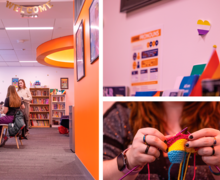Class of 2015 enrollment on target with expectations
A year after 167 more students enrolled than expected, Syracuse University appears to be on track to reach this year’s freshmen class target of 3,350 students.
As of Sunday, 3,317 students have decided to enroll in the Class of 2015, said Don Saleh, vice president for enrollment management at SU. Of those students, approximately 3,250 decided to enroll after being accepted by the university during the admissions process, he said. The remainder of the students decided to enroll after being accepted off the university’s waitlist, Saleh said.
The deadline for accepted students to enroll was May 1, but the university has been admitting students from the waitlist during the course of the past week, Saleh said.
‘Our plan was to have the responses come in about 125 short of our target and then go to the waitlist to finish the class,’ he said. ‘And we did that because we wanted to be sure we didn’t over-enroll the class.’
SU received a record 25,835 first-year applications in fall 2011 and accepted approximately 12,500 students, Saleh said. Of those 12,500 students, about 3,250 decided to enroll at SU, 100 students short of the university’s target enrollment of 3,350. To fill the remaining spots, students are being admitted from the waitlist, Saleh said.
This year’s waitlist has 1,927 students on it, and the university expects to admit around 300 students from the waitlist, Saleh said. SU plans to enroll more than its target of 3,350 students because it will lose some students over the summer, he said.
Less than 12 students were admitted from last year’s waitlist — which had 1,017 students on it — because the university had over-enrolled, he said. SU received 22,925 first-year applications in fall 2010 and accepted 13,694 students. Despite having a target of 3,300 students, the university enrolled 3,467 students.
Although they’ve already enrolled, some students will decide over the summer not to attend SU for various reasons, including financial situations, distance from home or deciding to take a year off before attending college to do something else, such as missionary work, Saleh said.
‘There’s all kinds of reasons as to why students decide not to come,’ he said. ‘We refer to that as our ‘summer melt,’ and we just need to be prepared for that melt.’
Saleh said initially enrolling about 3,250 students before admitting students from the waitlist gave the university a cushion, making it more difficult to over-enroll the class.
‘I think all the signs are that when we reconvene in August, we’ll have a class of very, very close to 3,350,’ he said. ‘I can’t predict the exact number, but I’d say we’ll be very close — not much above or not much below.’
The freshmen class in fall 2010 put stress on the university’s academic advisers, as they had 167 more students than they were originally planning on working with, Saleh said. The over-enrollment of the fall 2010 freshmen class also put pressure on the university’s housing system and those living in residence halls, he said.
Prior to enrolling more students than it had planned last fall, SU had plans to convert lounges being used as dorm rooms back into lounges, Saleh said. But because of the large freshmen class, the university was unable to do that, he said.
The Office of Housing, Meal Plan and I.D. Card Services had to use approximately 200 residence hall lounges as student dorm rooms because of the additional freshmen who enrolled in fall 2010, said Sara Miller, associate director of SU News Services, in an email.
Saleh said last year’s over-enrollment was taken into account when deciding to initially enroll around 3,250 accepted students and fill the remaining spots from the waitlist to get to the target of 3,350. He said he doesn’t expect any problems with enrollment for the fall 2011 freshmen class.
‘I speak to my colleagues in housing and residence life on a regular basis and none of us are anticipating problems with the number of students who we’re going to have to house,’ Saleh said. ‘The freshmen class size will be right on target, and therefore, our ability to house those students will be fine.’
But the housing office still has taken steps in preparation of housing the rising sophomore class, which is required to live in residence halls for one more year, and the targeted number of freshmen for fall 2011, Miller said.
The housing office has 188 beds at Park Point Syracuse on Comstock Avenue and University Village Apartments on Colvin, she said. The office also holds 64 beds at the Sheraton University Hotel and Conference Center and 60 beds at the Parkview Hotel on East Genesee Street, Miller said.
The 312 total beds at the four facilities were made available to upperclassmen during the housing reservation process that began in March, she said. The additional spaces allowed the housing office to hold 3,350 beds for the incoming freshmen, Miller said.
The space available within the residence halls is one of the factors that helps determine the overall class size, Saleh said.
He said: ‘We need to make sure that the sum of the nine undergraduate colleges comes to a number that fits within our ability to be comfortably housed with students.’
*****
Here’s a further breakdown of the Class of 2015 enrolled thus far:
The incoming freshmen class has more students from the Western and Southern parts of the United States, but has fewer students from the Northeast. This year’s freshmen class is made of 72.2 percent of students from the Northeast, compared to 74.6 percent last year, Saleh said.
The incoming class has 6.5 percent of its students from the West, compared to 4.9 percent the year before, he said. The class also has 8.2 percent of its students from the South, an increase over last year when it was 8 percent, Saleh said. The freshmen class for fall 2010 had 28.8 percent students of color, and this year’s incoming freshmen class is 31.6 percent students of color, he said.
This year’s freshmen class has 7.7 percent international students, compared to 6.6 percent for fall 2010’s freshmen class, Saleh said. The percentage of international students in the incoming freshmen class is likely to drop during the summer because of students’ distance from home, he said.
Of the 3,317 students enrolled in fall 2011’s freshmen class as of Sunday, nearly 40 percent are in the College of Arts and Sciences, Saleh said. The School of Architecture, the School of Information Studies and the School of Education each have 3 to 4 percent of the incoming freshmen class, he said.
The S.I. Newhouse School of Public Communications consists of 8 percent of the class, and the Martin J. Whitman School of Management and the College of Human Ecology each have 9 percent of the incoming class, Saleh said.
The L.C. Smith College of Engineering and Computer Science has 11 percent of the incoming freshmen class, and the College of Visual and Performing Arts has 14 percent of the class.
Published on May 10, 2011 at 12:00 pm
Contact Jon: jdharr04@syr.edu





